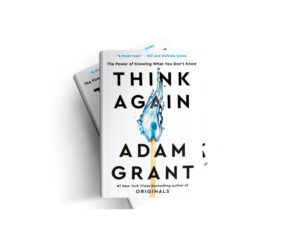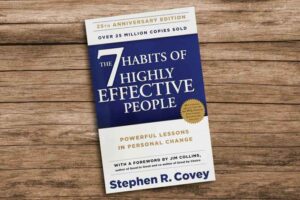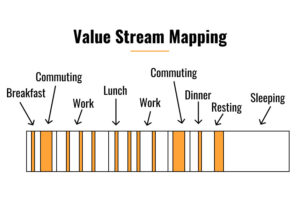Download this executive summary in PDF: Indistractable by Nir Eyal
Chapter 1: What’s Your Superpower?
- People get easily distracted by technology.
- Removing technology is not the solution, it will be replaced by other distractions. You need to “do the right things and stop doing the wrong things”.
Chapter 2: Being Indistractable
- The Greek myth of Tantalus is a story of perpetual distraction and desire: always yearning for something unattainable and just out of reach.
- Humans always have desires for more (money, status, knowledge, stuff).
- Traction pulls us toward what we want to accomplish. Distraction diverts us from accomplishing our goals.
- Internal triggers cue us from within, if I feel hungry I will eat a snack. External triggers are cues from the environment such as the ring of an email or a colleague talking to us. The key is to determine if these cues are tractions or distractions.
- Distractions will always exist, it is our responsibility to manage them.
PART 1: MASTER INTERNAL TRIGGERS
Chapter 3: What Motivates Us, Really?
- Distraction is a way to escape from reality and challenges (checking social media, watching television, staying at the office).
- The root cause is not the distraction but the pain we want to avoid.
Chapter 4: Time Management is Pain Management
- Happiness never lasts because our brain is biologically wired this way to incentive us to always strive for more as a species.
- Boredom, negativity bias, rumination, and hedonic adaption cause dissatisfaction to drive us for more to survive.
- Not being happy is our default state.
Chapter 5: Deal with Distraction from Within
- Mental abstinence is not a viable solution, it makes the desire and urges stronger.
- It is not the nicotine that makes smokers crave a cigarette but the time left before they can smoke again.
Chapter 6: Reimagine the Internal Trigger
- 4 steps to manage our urges:
-Look for the discomfort that precedes the distraction, focusing on the internal trigger.
-Write down the trigger that led to the distraction.
-Explore your negative sensations with curiosity.
-Beware of the liminal moments: Liminal moments are transitions from one thing to another throughout our days. For example, checking your mobile while waiting at the traffic light, then found yourself still looking at your phone while driving. - Surfing the urge: waiting for 10 minutes when we want to play with the phone and the urge will pass.
Chapter 7: Reimagine the Task
- Fun and play can be used as a tool to keep us focused and make tasks pleasurable.
- Play does not have to be pleasurable but to hold our attention.
Chapter 8: Reimagine Your Temperament
- Psychologist Roy Baumeister’s popularly accepted work on “ego depletion” and willpower as a finite resource has been called into question recently by other researchers.
- Ego depletion is a myth. Willpower is not a finite resource. Only those who believed that willpower was a finite resource got a boost of energy when taking some sugar.
- Mindset matters to overcome physical dependence such as drinking and smoking.
- You are powerless only if you think you are.
PART 2: MAKE TIME FOR TRACTION
Chapter 9: Turn Your Values into Time
- We protect our properties but we do not make enough effort to protect our time.
- Values define the person we want to be. They guide the choices we make.
- We must schedule some time to live our values to generate tractions and avoid distractions.
- Timeboxing: deciding what you are to do and when you are going to do it to make time for tractions.
- Make a calendar, and reflect on it every week to reduce distractions.
Chapter 10: Control the Inputs, Not the Outcomes
- Scheduling time for myself first.
- Show up when I say I will give myself time to do what I planned to do.
Chapter 11: Schedule Important Relationships
- Time with family and important relationships also should be scheduled. This time should not be what is left over.
- Quality relationships keep us healthier and happier.
- Quality friendship needs 3 elements: someone to talk to, someone to depend on, and someone to enjoy.
Chapter 12: Sync with Stakeholders at Work
- A detailed timebox schedule helps to build trust between employer and employee.
- By sharing the timebox schedule with managers, they can adjust the priorities and reduce distractions.
PART 3: HACK BACK EXTERNAL TRIGGERS
Chapter 13: Ask the Critical Question
- The Fogg Behavior Model (developed by Stanford professor BJ Fogg). For a behavior (B) to occur, three things must be present simultaneously: motivation (M), ability or the ease of the action (A), and a trigger (T). The equation: B=MAT
- External triggers play a key role in the B=MAT equation. External triggers come in many disguises including device notifications and interruptions from other people.
- Having your phone nearby, your brain needs to work hard to ignore it. Without the phone in sight view, you will be able to focus more.
- Are the external triggers tractions or distractions?
Chapter 14: Hack Back Work Interruptions
- Reducing interruptions limit errors.
- Use tools to signal a clear message that you do not want to be interrupted.
Chapter 15: Hack Back Email
- Email is addictive because we anticipate good news and bad news.
- Reciprocity: we tend to reply to emails we receive generating an endless cycle of emails.
- Sending fewer emails to receive fewer emails.
- Open up “Office Hours”: do not reply immediately to emails, instead send an automatic reply telling the sender to book a meeting with you if the matter is important. With time, the sender may solve the problem by himself.
- Slow Down and Delay Delivery: by sending fewer emails you will receive fewer emails. Delay delivery until Monday morning for example to avoid stressing your coworkers and not receiving emails during weekends.
- Eliminate Unwanted Messages: unsubscribe from unwanted newsletters. Answer your emails in batches all at once.
- Play Tag: Tag emails (Today or This week).
Chapter 16: Hack Back Group Chat
- Rule 1: Use It Like a Sauna: stay for a while then get out.
- Rule 2: Schedule It: timebox schedule when you check and reply in the group.
- Rule 3: Be Picky: Carefully select the persons you want to invite to the group chat.
- Rule 4: Use It Selectively: use chat group when it gives us traction.
Chapter 17: Hack Back Meetings
- Meetings are often a distraction to avoid dealing with problems.
- Meetings should be used to get consensus.
- Before calling for a meeting, clarify the agenda and prepare a brief with a solution.
- Brainstorming is better in a small group and participants should brainstorm alone before.
- People should avoid taking their smartphones and computer so they can engage more during the meeting. Technology is a way to be physically present but the mind is away.
Chapter 18: Hack Back Your Smartphone
- Remove: remove apps that do not align with your value
- Replace: you still can use important apps on the desktop
- Rearrange: put your primary tools and inspirational apps on the home screen, put the slot machines on another page
- Reclaim: disable app notifications that distract you, and use the “do not disturb” feature.
Chapter 19: Hack Back Your Desktop
- Clean up and simplify your desktop
- Remove notifications
Chapter 20: Hack Back Online Articles
- Never read articles on your web browser, save them and read them later (using the app Pocket)
- Multi-channels multitasking: using different channels while multitasking such as listening to a podcast while commuting.
Chapter 21: Hack Back Feeds
- Eliminate the news feeds
- Use tools to select what you only want to see while you are on social media.
PART 4: PREVENT DISTRACTION WITH PACTS
Chapter 22: The Power of Precommitments
- A freely made decision that is designed and intended to bind oneself to the future.
- Use precommitment only after mastering internal triggers, making time for traction, and removing external triggers.
Chapter 23: Prevent Distraction with Effort Pacts
- Increasing the amount of effort required to perform an undesirable action.
- Undesirable actions become more difficult to do.
- Find a partner to work together, social pressure will discourage you to slack off.
Chapter 24: Prevent Distraction with Price Pacts
- Putting money on the line encourages us to do what we say we will.
- Loss aversion: people are more motivated to avoid loss than to seek gains.
Chapter 25: Prevent Distraction with Identity Pacts
- The perception of who we are changes what we do.
- Our beliefs shape our behaviors, the opposite is also true.
PART 5: HOW TO MAKE YOUR WORKPLACE INDISTRACTABLE
Chapter 26: Distraction is a Sign of Dysfunction
- Jobs, where employees have high expectations and low control, lead to depression.
- When people feel bad, they use distraction to avoid pain.
- Technology is a symptom, not the root cause.
Chapter 27: Fixing Distraction is a Test of Company Culture
- Psychology safety: a belief that one will not be punished or humiliated for speaking up with ideas, questions, concerns, or mistakes.
- Frame the work as a learning problem, acknowledge your fallibility, and ask a lot of questions.
Download this executive summary in PDF: Indistractable by Nir Eyal








